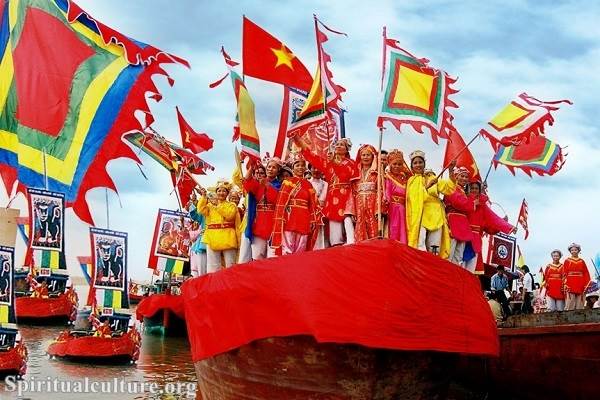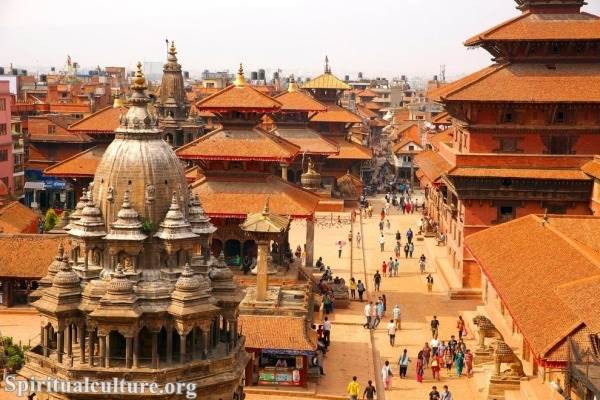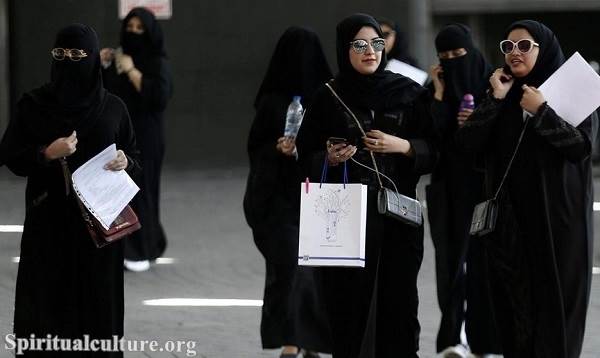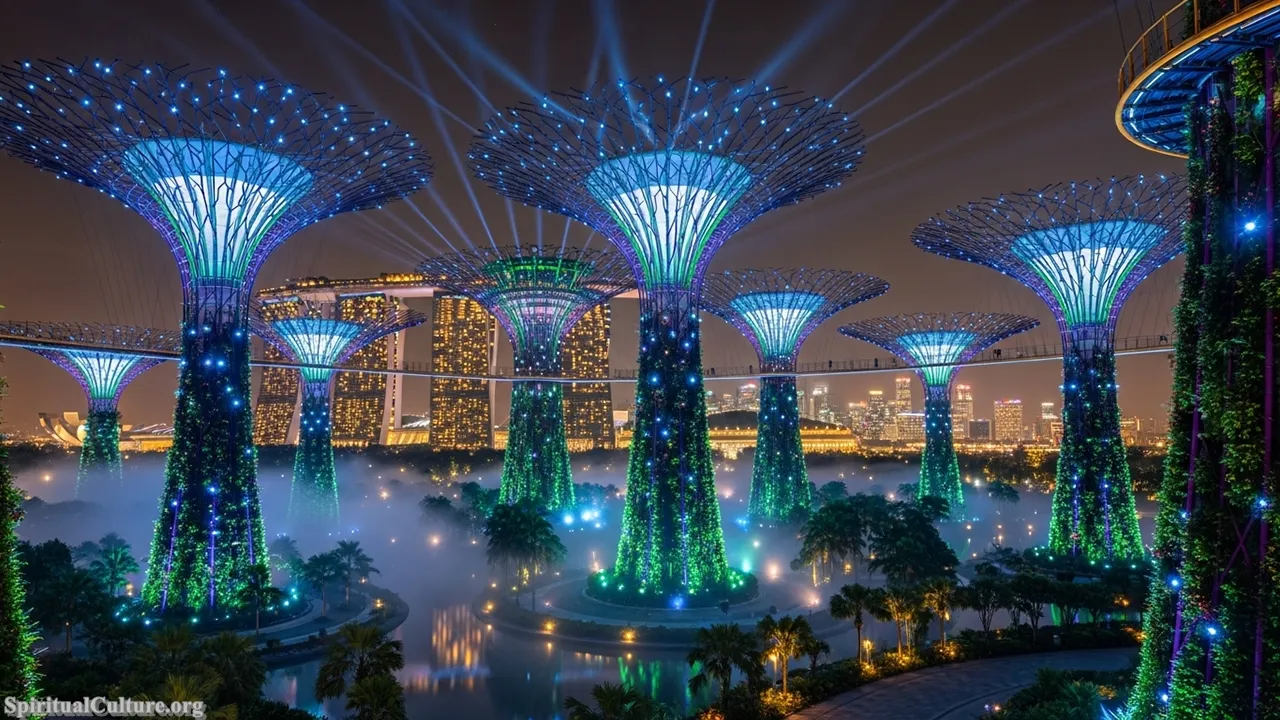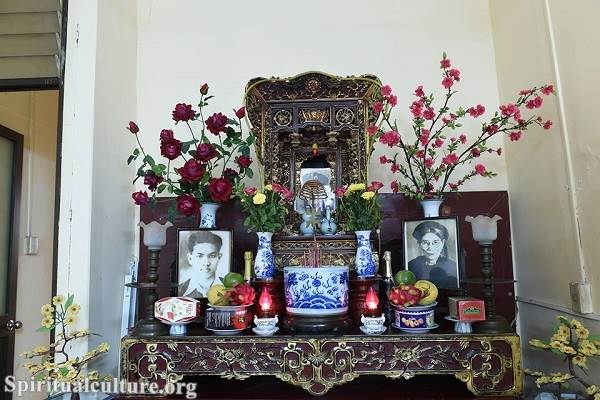Saudi Arabia, the heartland of Islam and the Arabian Peninsula, is a nation whose identity is woven from profound spiritual devotion and centuries of tribal heritage. Its cultural symbols are far more than mere emblems; they are living narratives of faith, justice, and resilience shaped by the desert environment and the historical imperative of unification. Understanding these symbols is paramount to grasping the Saudi national conscience.
At Spiritual Culture, we move beyond mere nationalistic icons to illuminate the deeper, enduring spiritual and cultural significance. This comprehensive guide, fact-checked for the Current Time of Writing, ranks the most influential symbols based on their global recognition, religious weight, and historical longevity, ranging from the sacred creed on its flag to the unifying tradition of hospitality.
The symbols listed below represent a tapestry of the Kingdom’s identity—from its unifying Islamic faith and its commitment to justice, to the hospitality that defines its social fabric. This is our evidence-based, culturally consistent ranking of the ten symbols that best articulate the Saudi spiritual and cultural journey.
Table of the Top 10 Most Recognized Saudi Cultural Symbols by Spiritual and Historical Impact
| Rank | Cultural Symbol | Core Significance | Spiritual/Heritage Status |
|---|---|---|---|
| 1 | The Shahada on the National Flag | The Islamic Creed (Monotheism) | Ultimate Religious Symbol; Sacred text prevents flag from being lowered to half-mast. |
| 2 | The Holy City of Mecca (Makkah) | Qibla and Hajj Destination | Center of the Islamic World; Site of the Kaaba and Al-Masjid al-Haram. |
| 3 | The Arabian Palm Tree | Growth, Vitality, and Sustenance | National Emblem inclusion; Mentioned over 20 times in the Quran. |
| 4 | The Sword (on the Flag/Emblem) | Justice, Security, and Sovereignty | Symbol of unification campaigns and the defense of Islamic principles. |
| 5 | Arabic Coffee and Dates Ritual | Hospitality and Generosity | UNESCO Intangible Cultural Heritage of Humanity (Arabic Coffee, 2015) and central to all social gatherings. |
| 6 | The Thobe and Ghutra/Agal | Modesty and Cultural Identity | Traditional dress reflecting Islamic principles and adaptation to the desert climate. |
| 7 | Arabic Calligraphy (Thuluth Script) | Artistic Expression of the Holy Word | UNESCO Intangible Cultural Heritage of Humanity (2021); Featured prominently on the national flag. |
| 8 | Al-Ardah (National Sword Dance) | Strength, Unity, and Valor | UNESCO Intangible Cultural Heritage of Humanity (2015); Colloquially known as the national dance. |
| 9 | The Arabian Camel | Resilience and Bedouin Heritage | Historical “ship of the desert,” central to Bedouin life; cultural focus in the “Year of the Camel” (2024). |
| 10 | At-Turaif District in Diriyah | Birthplace of the Saudi State | UNESCO World Heritage Site; Symbolizes the historical roots and foundation of the Kingdom. |
Top 10. At-Turaif District in Diriyah
The mud-brick ruins of the At-Turaif district, located in Diriyah, serve as a monumental symbol of Saudi Arabia’s origin story. This UNESCO World Heritage Site was the first capital of the Saudi State, established in the 18th century, making it the physical and political cradle from which the Kingdom’s narrative unfolded. Its architecture—the distinct Najdi style—is a testament to the resourcefulness and artistry of early Arabian settlements, reflecting a profound connection to the desert environment from which the nation’s foundation sprang.
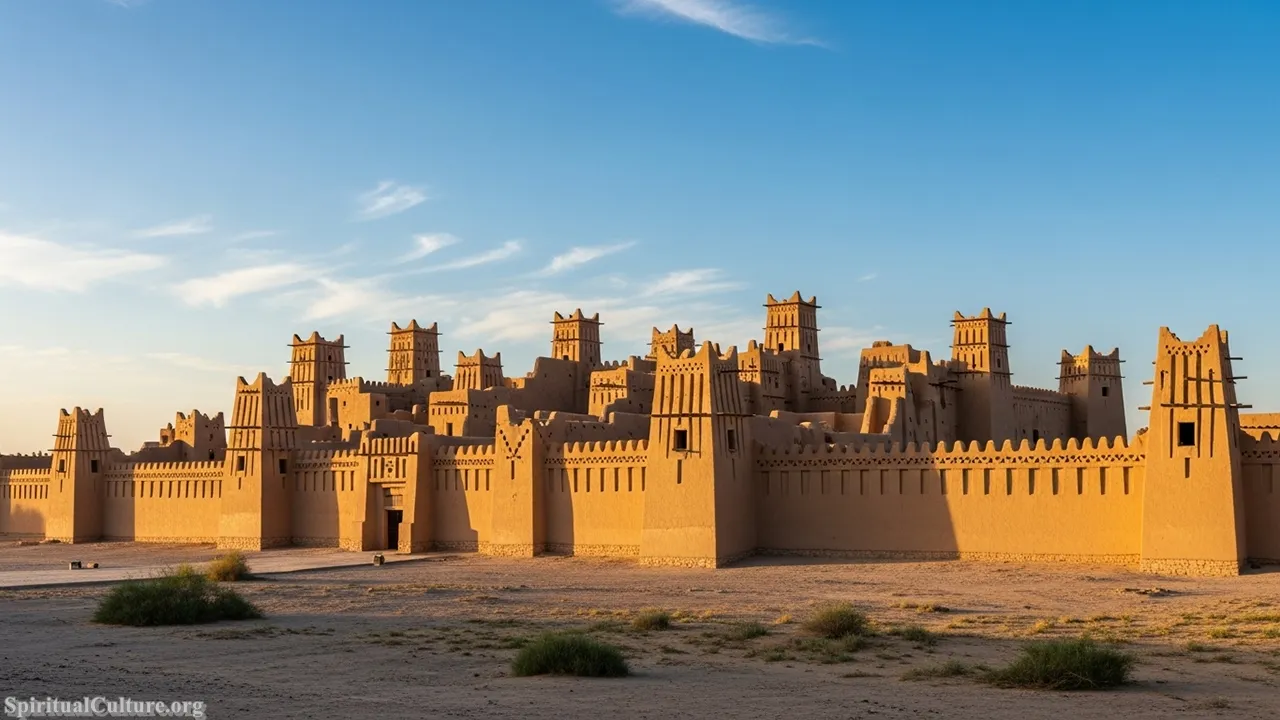
We rank At-Turaif here for its unparalleled historical significance as the undisputed starting point of the modern Saudi state, though its direct spiritual impact is more secular than other symbols on this list. Its power lies in embodying the resilience and political will of the House of Saud, offering a palpable link to the core values of governance and unification. The ongoing preservation and development efforts under Vision 2030 underscore its role as a sacred site of national heritage and identity.
The lesson of At-Turaif is that even the greatest nations arise from humble beginnings, founded on firm principles. Its mud walls teach a moral of persistence and connection to the land, reminding Saudis of the long, challenging journey to national unity. Preservation of this site is crucial, as it offers a tactile experience of the Kingdom’s deep-rooted historical continuity.
Cultural/Spiritual Highlights:
- Birthplace of the First Saudi State in 1744.
- UNESCO World Heritage Site since 2010.
- Exhibits the traditional, sustainable Najdi architecture.
Top 9. The Arabian Camel
The Arabian camel is a revered creature, representing the sheer resilience and survival of the traditional Bedouin way of life across the Arabian Peninsula. Known as the “ship of the desert,” its cultural recognition is deeply ingrained, extending far beyond utility to poetry, folklore, and racing traditions. The designation of 2024 as the “Year of the Camel” further solidifies its status as a cultural icon, celebrating its civilizational significance in the Current Time of Writing.
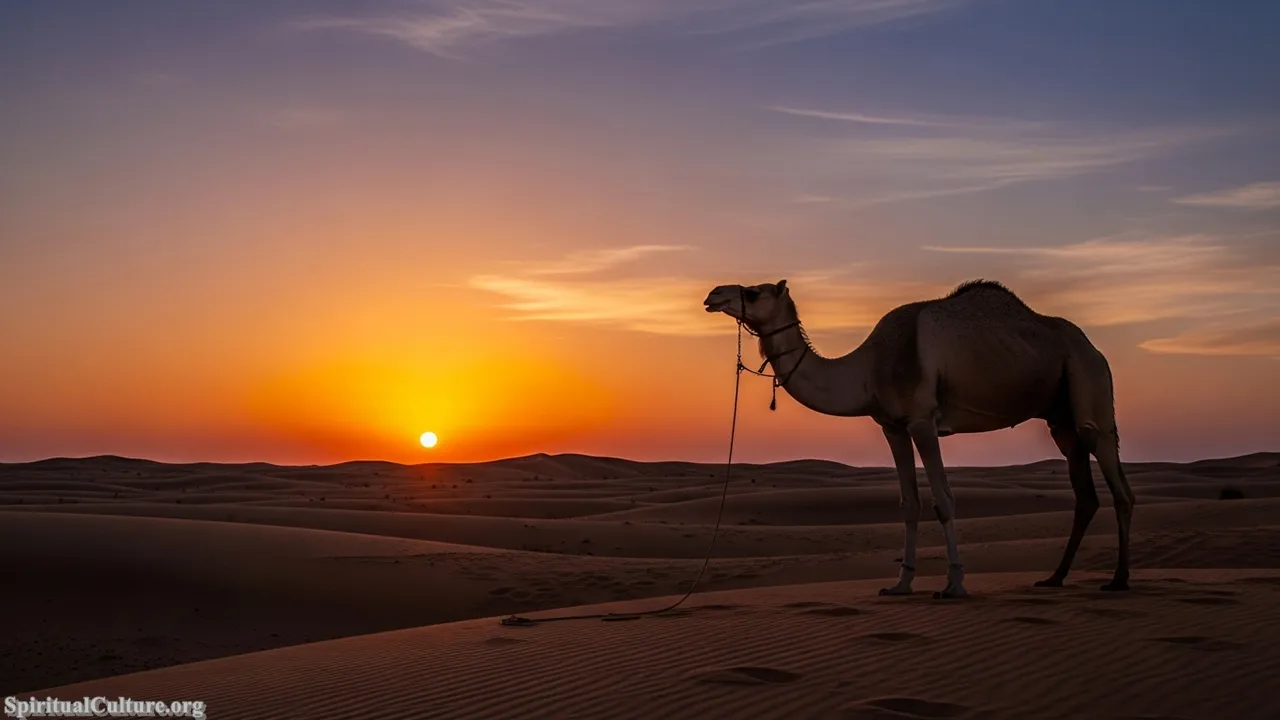
The camel’s high rank is due to its symbolic spiritual impact—a lesson in perseverance and self-sufficiency, often referenced in Islamic texts for its hardiness. It is the silent, enduring partner in the ancient trade routes and migrations that shaped the region’s demographics and culture. Its connection to the concept of sabr (patience/endurance) is a key cultural value, linking the animal to a deeper, reflective human quality essential for life in the harsh Arabian environment.
The lasting value of the camel as a symbol is its living link to the nomadic past, teaching younger generations about the ingenuity and traditional knowledge of their ancestors. Its presence in festivals, poetry, and even the national emblem’s surrounding ecosystem is a celebration of the desert’s profound, formative role in Saudi identity.
Cultural/Spiritual Highlights:
- Referred to as the “ship of the desert,” central to Bedouin survival.
- UNESCO inscribed Al-Heda’a (camel calling) in 2022.
- Symbol of resilience, patience, and traditional knowledge.
Top 8. Al-Ardah (National Sword Dance)
Al-Ardah, colloquially known as the Saudi National Dance, is a potent and dynamic cultural performance, traditionally a war dance that has evolved into a centerpiece of national celebrations, weddings, and festivals. Performed by rows of men reciting poetic verses and wielding swords, it is a unified display of collective strength, tribal pride, and martial valor. Its recognition by UNESCO as Intangible Cultural Heritage highlights its formal importance to the Kingdom’s identity.
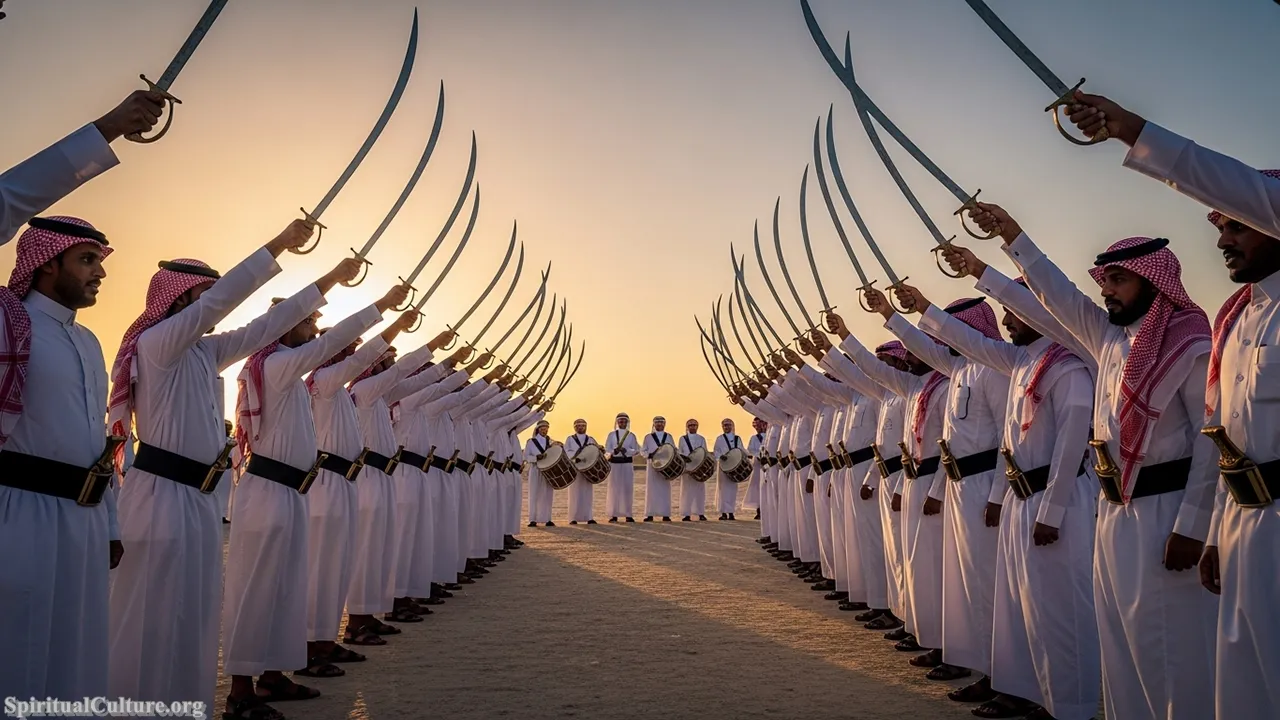
The Ardah’s spiritual impact is one of communal solidarity and moral courage. It physically embodies the concept of unity under a shared banner—a direct reflection of the unification campaigns that forged the Kingdom. The rhythmic drumming and recitation of poetry, particularly Nabati poetry, serve to transfer historical narratives and moral lessons, making the performance a living, moving archive of cultural memory and cohesion.
As a preservation value, Al-Ardah represents the enduring spirit of the Arabian warrior, channeled into a disciplined, celebratory art form. It teaches the vital lesson of teamwork and communal loyalty, demonstrating that strength is found not just in individual prowess but in harmonious, collective action—a foundational principle of the national ethos.
Cultural/Spiritual Highlights:
- UNESCO Intangible Cultural Heritage of Humanity (2015).
- A rhythmic sword dance symbolizing unity, courage, and strength.
- Traditional verses often praise the leader and the nation’s victories.
Top 7. Arabic Calligraphy (Thuluth Script)
Arabic calligraphy is not merely an art form in Saudi Arabia; it is the highest form of visual expression, profoundly intertwined with the spiritual heart of the nation. As an art that gives form to the Holy Quran and the Shahada, it carries immense sanctity. The Thuluth script, in particular, is famed for its flowing, elegant curves and is the script chosen to inscribe the Islamic creed on the national flag, underscoring its authoritative cultural status in the Current Time of Writing.
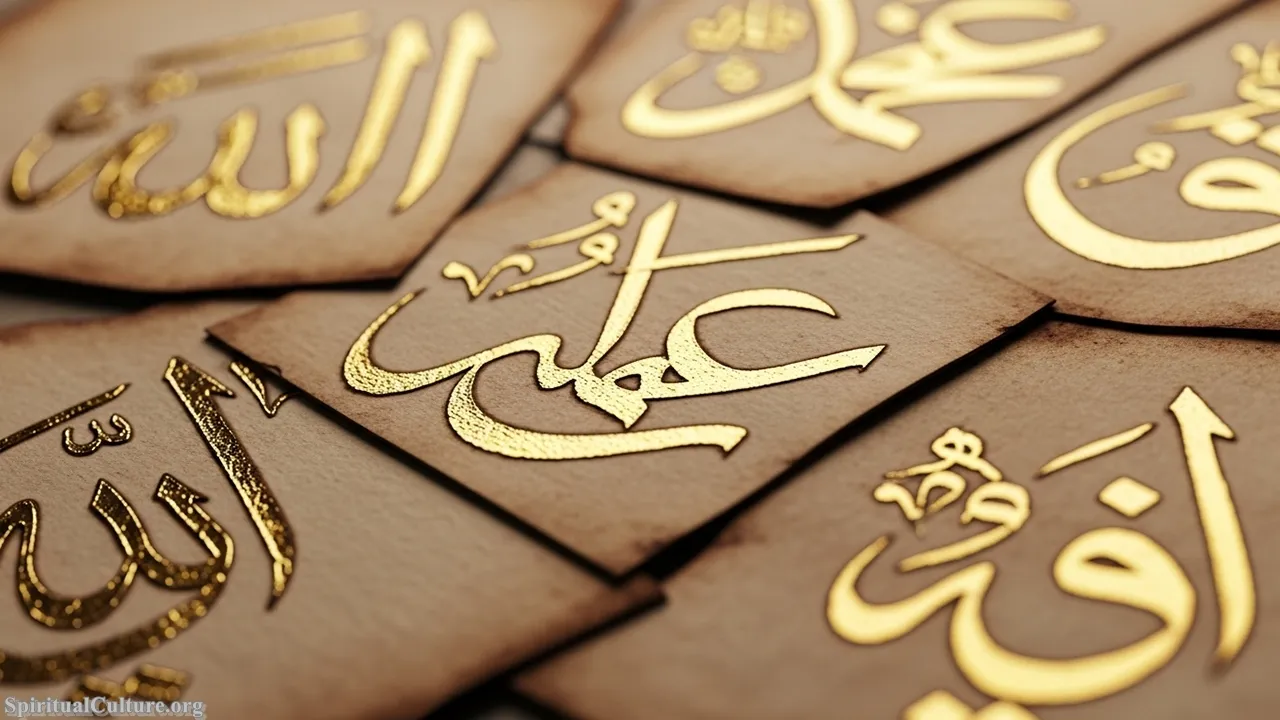
Its powerful spiritual impact derives from its function as a conveyor of the divine word, making the calligrapher’s skill a sacred trust. Calligraphy is a practice of meditation and discipline, reflecting the Islamic principle of beauty in order and precision. Its UNESCO inscription in 2021 recognized its value as an “inherited artistic practice,” deeply embedded in Arab and Saudi identity, transcending utility to become pure spiritual aesthetics.
The moral lesson of calligraphy is the pursuit of perfection and the honoring of the word. It encourages meticulousness and reverence for language, reminding society that the essence of faith and culture is communicated through carefully preserved and beautifully rendered language. Its preservation ensures the visual continuity of the Islamic intellectual tradition.
Cultural/Spiritual Highlights:
- UNESCO Intangible Cultural Heritage of Humanity (2021).
- Thuluth script is used for the Shahada on the national flag.
- The primary Islamic visual art form, reflecting divine beauty and order.
Top 6. The Thobe and Ghutra/Agal
The traditional male attire—the flowing thobe, the checkered or white ghutra (headscarf), and the black agal (cord-like headband)—is an instant and universally recognized symbol of Saudi cultural identity. This attire is a functional adaptation to the desert heat, allowing for air circulation, yet its primary significance is cultural and spiritual, adhering to Islamic codes of modesty and dignity. The variation in color and style often indicates regional heritage, but the overall form is a national constant.
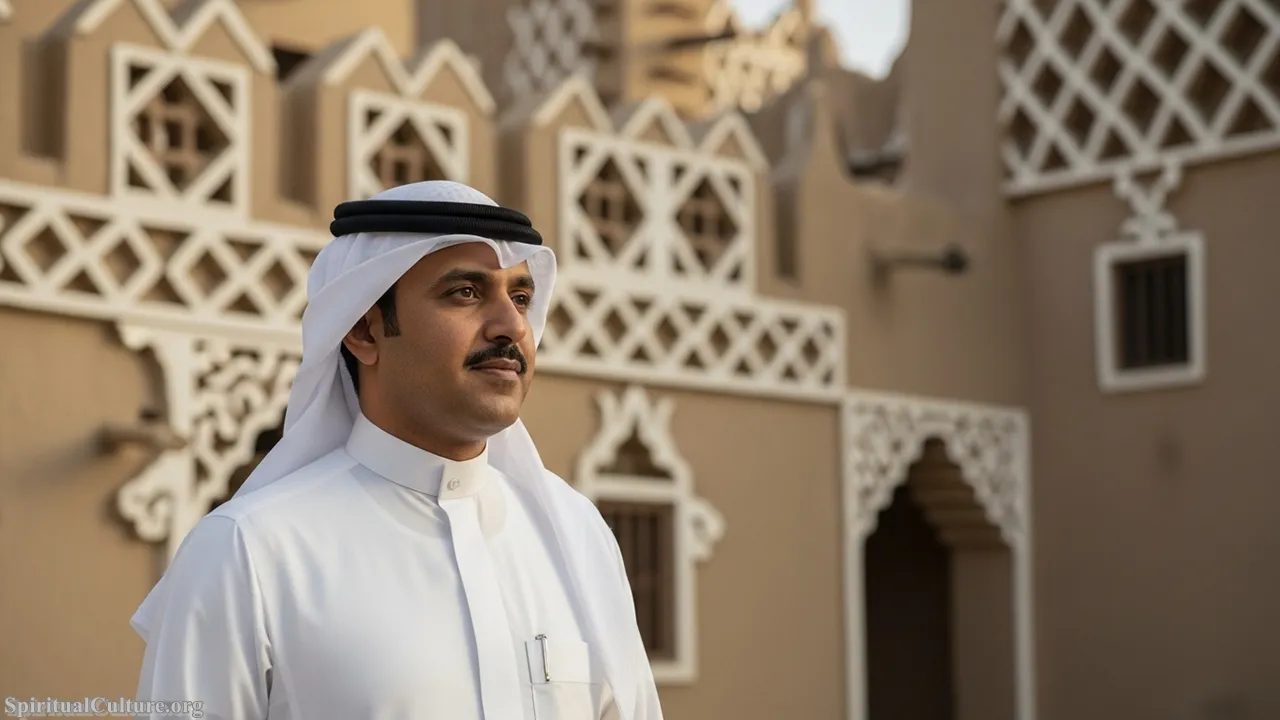
The spiritual impact is centered on the principle of modesty (haya), a core value in Islam. By wearing this simple, dignified clothing, men signal their adherence to both faith and cultural tradition. The agal, originally used by Bedouins to tether their camels, has evolved into a symbol of pride and readiness, tying the wearer to the historical practicality and honor of the Arabian past.
The cultural value of this attire is its powerful ability to unify identity across the Kingdom’s diverse regions. It reflects the moral lesson that clothing can be a statement of dignity and adherence to shared values, rather than just fashion. Its continued prevalence in daily life reinforces a visible commitment to heritage in a rapidly modernizing society.
Cultural/Spiritual Highlights:
- The national male dress, adhering to Islamic modesty.
- The agal (headband) historically tethered camels, symbolizing honor and readiness.
- Represents a unified cultural identity across diverse Saudi regions.
Top 5. Arabic Coffee and Dates Ritual
The serving of gahwa (Arabic coffee) and dates is perhaps the most profound and tangible expression of Saudi hospitality, or karam. This ritual transcends mere refreshment; it is a meticulously choreographed social transaction that embodies generosity, honor, and respect for guests. Coffee is roasted, ground, and prepared in front of the guest, often using the distinctive dallah (coffee pot), a ritual recognized by UNESCO as Intangible Cultural Heritage.

The spiritual impact of this symbol is rooted in the Islamic imperative of honoring the guest, a social obligation and a moral duty. Dates, often served alongside the coffee, are themselves sacred—a staple food mentioned repeatedly in the Quran, linked to sustenance and blessing. The act of offering both is a non-verbal declaration of peace and welcoming, forging social bonds essential to community survival in the desert.
The moral lesson is the absolute supremacy of hospitality, teaching that generosity towards strangers and friends alike is a mark of noble character. The preservation of this ritual, formalized as “Saudi coffee” by the Ministry of Culture in 2022, is critical, as it is the most widespread cultural practice that defines the warmth and humanism of the Saudi people.
Cultural/Spiritual Highlights:
- UNESCO Intangible Cultural Heritage (2015).
- Dates are a sacred food, mentioned in the Quran.
- The primary ritual symbolizing Arab generosity (karam) and honor.
Top 4. The Sword (on the Flag/Emblem)
The single, unsheathed sword appearing on the national flag and the Saudi emblem (crossed with a palm tree) is a powerful, unambiguous symbol of justice, security, and the historical strength of the nation. It is a cultural witness to the unification campaigns led by King Abdulaziz, where the sword was instrumental in establishing sovereignty. Its design on the flag, placed below the Shahada, signifies the nation’s readiness to defend its faith and its commitment to upholding justice.
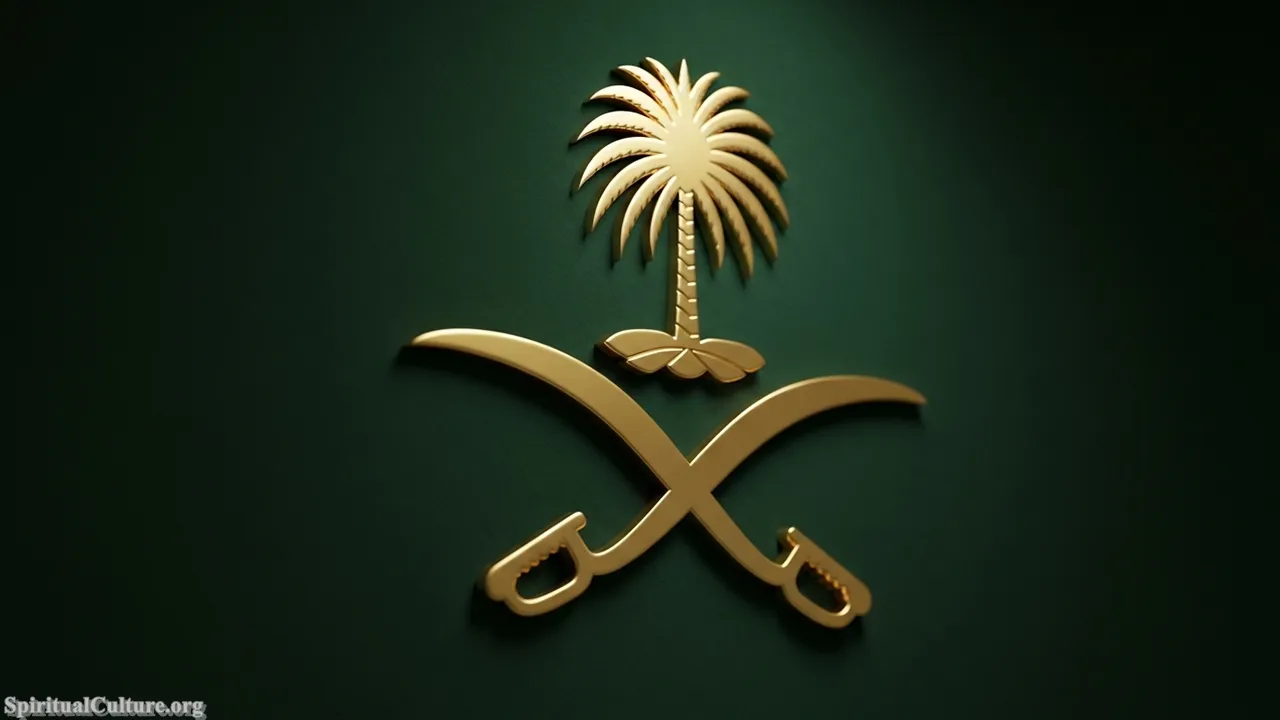
Its spiritual significance is found in its association with the protection of the Islamic creed. The sword’s presence asserts the state’s responsibility to maintain order and dispense justice in accordance with religious law. The white color of the sword on the flag symbolizes purity and peace, reinforcing the idea that the strength represented is one of defense and righteous application of authority, not aggression.
The moral lesson of the sword is the inextricable link between strength and justice: that prosperity (represented by the palm tree in the emblem) is only possible when the state ensures security and upholds the rule of law. It is a symbol of solemn responsibility and national vigilance.
Cultural/Spiritual Highlights:
- Symbolizes justice, security, and the Kingdom’s sovereignty.
- Represents the historical unification of the regions under the House of Saud.
- Its presence below the Shahada signifies the defense of the Islamic faith.
Top 3. The Arabian Palm Tree
The Arabian Palm Tree, especially the date palm, stands tall as the quintessential symbol of life, abundance, and growth within the harsh Arabian environment. Its prominence in the Saudi emblem, placed above the crossed swords, signifies that prosperity and sustenance are elevated above all else. Historically, the date palm has provided shelter, food, and building materials, making it a foundational element of the Kingdom’s agricultural and social history.

The spiritual impact is profound, as the palm is mentioned numerous times in the Holy Quran (over 20 references), often in the context of paradise and divine blessing. It is a symbol of vitality and resilience, capable of thriving in extreme conditions, thereby reflecting the perseverance of the Arab people themselves. Its fruit, the date, is central to Islamic tradition, notably being the recommended food for breaking the fast during Ramadan.
The palm tree’s cultural message is one of hope and enduring connection to the land. It teaches the preservation value of sustainable life and the rewards of patient cultivation. The registration of the Date Palm as UNESCO Intangible Cultural Heritage in 2019 affirms its role as a cross-generational cultural anchor.
Cultural/Spiritual Highlights:
- Mentioned over 20 times in the Quran, symbolizing blessing and sustenance.
- The central element of the Saudi emblem, representing prosperity and growth.
- UNESCO Intangible Cultural Heritage (2019) in partnership with Arab nations.
Top 2. The Holy City of Mecca (Makkah)
Mecca holds an incomparable place as the spiritual epicenter of the Islamic world, instantly recognizable across all cultures and faiths. It is home to the Kaaba, the House of God and the ultimate focal point (Qibla) of Muslim prayer worldwide. As the site of the annual Hajj pilgrimage—one of the Five Pillars of Islam—and the lesser pilgrimage (Umrah), Mecca is a city defined by an eternal flow of devotion, embodying the unity of the global Ummah (Muslim community).
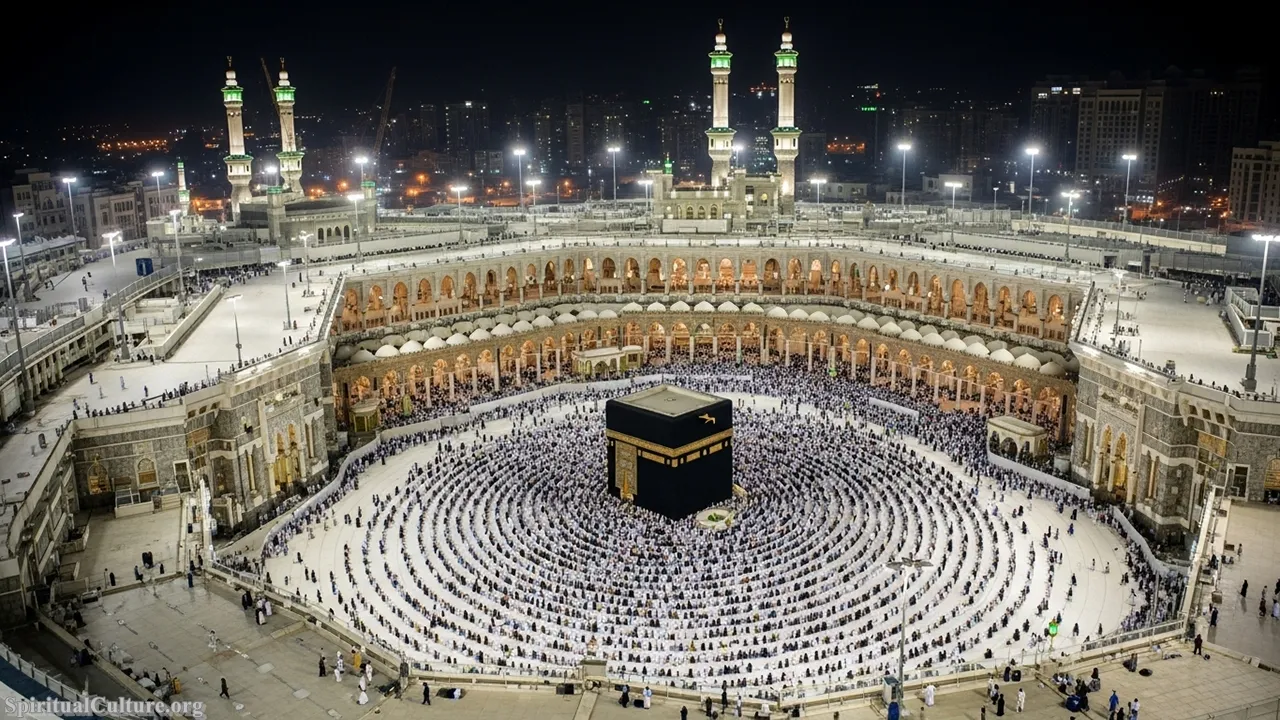
Its spiritual impact is absolute, defining the Kingdom of Saudi Arabia’s unique role as the Custodian of the Two Holy Mosques (Mecca and Medina). The city represents the direct link between the Kingdom and the foundational narrative of Islam, placing a solemn religious responsibility upon the Saudi leadership. The architectural grandeur of Al-Masjid al-Haram, which houses the Kaaba, is a testament to continuous commitment to facilitating global worship.
Mecca’s value lies in its power to unite, teaching the profound moral lesson of human equality and spiritual focus, as millions of pilgrims shed worldly distinctions to perform the rites of Hajj. It is the core anchor of the Saudi spiritual identity, transcending national borders to influence the lives of over 1.8 billion Muslims globally.
Cultural/Spiritual Highlights:
- Site of the Kaaba (Qibla), the most sacred site in Islam.
- Center of the Hajj, one of the Five Pillars of Islam.
- Symbolizes the unity and equality of the global Muslim community (Ummah).
Top 1. The Shahada on the National Flag
The Shahada—the Islamic declaration of faith: “Lā ʾilāha ʾillā-llāh, Muḥammadun rasūlu-llāh” (There is no deity but God; Muhammad is the Messenger of God)—inscribed in white Arabic Thuluth script upon the green field of the Saudi flag, is the single most recognized and important cultural symbol. It is the bedrock of the nation’s spiritual and legal foundation, making the flag an eternal declaration of monotheism. Due to its sacred nature, the flag is never flown at half-mast, even in times of mourning.

The spiritual impact is the highest possible: it is the primary creed of Islam itself. The symbol represents the unwavering commitment of the Kingdom to its faith, a commitment that predates its modern founding and links the nation to the earliest Islamic movements. The surrounding green color symbolizes Islam and peace, reinforcing the Shahada as the ultimate source of authority, identity, and justice within the nation.
The moral lesson of this symbol is one of uncompromising devotion and purpose. It is the defining statement that informs all cultural, legal, and social life in the Kingdom, teaching that national identity is inseparable from spiritual conviction. Its permanent and central placement on the flag ensures that the spiritual foundation remains the ultimate cultural symbol for all Saudis in the Current Time of Writing.
Cultural/Spiritual Highlights:
- The Islamic Creed, “There is no deity but God; Muhammad is the Messenger of God.”
- Its sanctity means the flag is never lowered to half-mast or displayed vertically.
- The founding principle of the Saudi state and its legal/social framework.
Conclusion
The cultural symbols of Saudi Arabia are a profound confluence of religious devotion, historical resilience, and deep-seated Arabian hospitality. From the ultimate spiritual sovereignty proclaimed by the Shahada on its flag to the unifying tradition of the Ardah dance and the welcoming ritual of Arabic coffee, each symbol tells a part of the Kingdom’s complex and compelling story. At Spiritual Culture, we celebrate the fact that these are not relics of the past but living practices and emblems that actively shape a vibrant, forward-looking national identity under the umbrella of a timeless spiritual conviction.
As the Kingdom navigates a period of rapid modernization, these top ten symbols serve as essential anchors, ensuring that progress remains rooted in heritage. They are the visible, tactile, and spiritual manifestations of the Saudi soul—a testament to a culture that reveres justice, cherishes generosity, and places its faith at the forefront of its existence. We encourage all to look beyond the surface and recognize the deep spiritual meaning that elevates these cultural icons to world-class status.
